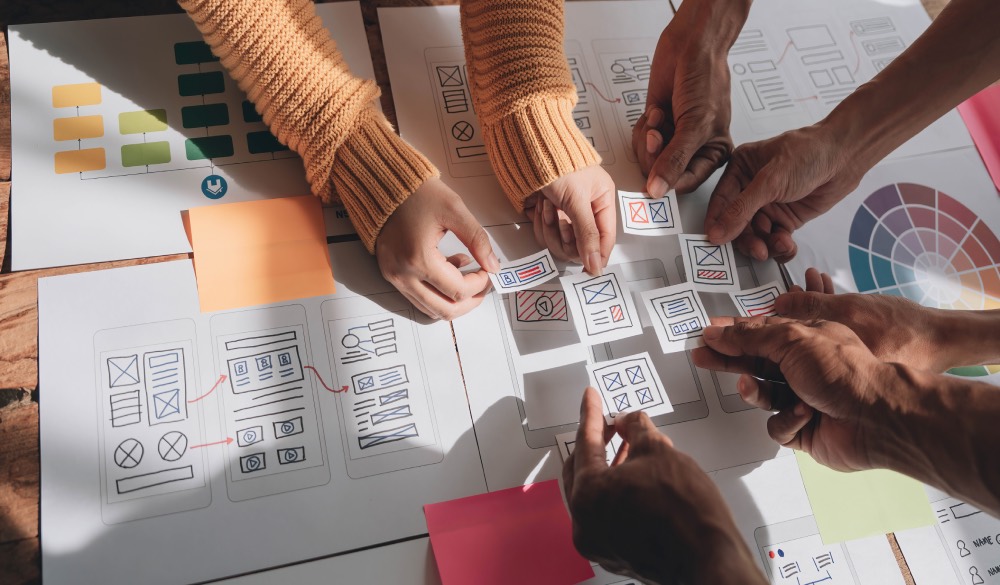There is no better structure for codifying the way your company or organization thinks, communicates, and acts around design than a design system. It’s quickly replacing traditional design documentation as the go-to solution for design organization and workflow. It also effortlessly organizes and displays interactive elements.
There are numerous resources available that go into detail about what design systems comprise and how they are constructed.
The question that might arise while you conduct your research is – how does a design system improve client experiences? Here in this article, we’ll look at five key ways design systems accomplish this.
It’s important to understand that when we talk about design systems, we’re not merely talking about a collection of graphic design files on a hard drive somewhere inside your company.
A design system is a globally accessible, living, breathing platform of user experience and user interface patterns that can negatively impact the customer experience of any digital product you produce.
Consistency
Companies often experience issues with design consistency in one form or another. The spread of confusion and unnecessary effort is a serious issue with design inconsistency.
Consider what it would be like if your design team was charged with designing UX or UI from scratch every time they were given the task.

That would necessitate a massive amount of effort! While design templates are a step in the right way, putting things together while referring to instructions may still take a significant amount of time and effort.
That is, assuming that the person who built the template gave instructions, which isn’t usually the case.
Furthermore, instructions may differ from one designer to the next. Furthermore, instructions may differ from one designer to the next, typically due to a lack of a common language, resulting in even more inconsistencies.
Imagine your team having a universally accessible design resource with ready-made materials that covered a wide range of use-cases, as well as the ability to quickly construct items — all with clear, simple, and most crucially, organization-approved instructions. It could take only a few hours to move from concept to prototype, rather than a few days. This is what having a well-defined design system feels like.
Design systems ensure that your business’s design elements and associated terminology are used consistently throughout the organization. Finally, you’ll have an output that meets your client’s expectations. It feels like a natural extension of your organization, rather than a fragmented, disjointed experience.
Modernization
Some businesses may concentrate their efforts on a single digital product. Others may have full product suites catering to various consumers and demands. Having a well-defined design system that catalyzes modernization, regardless of which is in play at your company, is a tremendous asset. As your company grows, it’s critical to be able to pivot and adjust to market developments in real-time, as well as successfully meet changing client expectations. Modernization can be applied in two ways.
One of them entails bringing an out-of-date digital product up to date. The ability to quickly handle crucial changes in how your digital products provide the desired services is the second use-case of modernization.
In the first case, modernizing an out-of-date digital product may take some time to complete. If your design team is working on one area at a time, design systems can assist by combining newly defined patterns and components as they are developed, making the build-out process easier to complete over time. Once the digital product is fully updated, it becomes a go-to resource for both design and development teams for its ongoing evolution.
Let’s imagine your digital product relies on third-party solutions for critical consumer tasks, such as WordPress plug-ins for conventional websites or integrated digital product platform services. If the third-party solution is no longer viable for any reason – for example, the pricing is too high or the core feature set changes – you must be able to pivot swiftly to provide the crucial functionality your customer needs.
Design systems capture the essential details of what has been constructed so that equivalent third-party services can be sourced and altered, or – if time and money are not an issue – built from the ground up internally.
This all adds up to one of the most significant advantages of having a well-developed design system in place in your company: a consistent, efficient, and modern approach to brand uniformity.
Efficiency
Having a consistent design approach immediately improves the efficiency of how your design team works and functions on a daily basis. Rather than being overburdened with a single project or product that necessitates a significant amount of time and thought, numerous design streams might emerge at the same time. The time-consuming work of creating design patterns and components is now complete.
If your design team hits capacity, it is also considerably easy to engage more help. Onboarding new employees requires only a little amount of resources. The platform teaches and informs newcomers, allowing them to swiftly integrate and contribute.
It’s vital to emphasize that design teams aren’t the only group of collaborators who profit from a well-defined design system.
When typical design-related concerns can be resolved without interrupting your design team’s workstream, efficiency in development teams organically grows. Design and development requirements, such as core values and user stories, can simply be added to commonly used user experience and user interface patterns and components.
Branding
Every digital product your company develops is a direct extension of your brand and business, and it’s this that your customers are judging you on every time they use it. If your digital product appears to be an aggregation of separate products and functions, it may represent how you conduct business and indicate a lack of concern for customer experience.
When you have a design system in place, things like these can be avoided. Design systems not only ensure the consistent and efficient use of UX UI patterns and components but it may also address and emphasize the necessity of properly integrating brand standards. This could make or break a customer’s experience with your product.
Branding is more than just logos, colors, and appearance. Core principles, market position, and value proposition are all part of branding. Using well-thought-out voice and tone rules, these serve to provide instances of real-world use. These important brand features are frequently offered up in multiple sets of material meant for different audiences within many businesses and hence are not passed on to everyone working on a project or product.

The flaw in this method of communicating brand information is that design teams do not see the whole picture.
Alignment is essential for ensuring that every member of your team, regardless of function, knows the nature and value of your business and how it reflects it to your customers. With correct alignment, teams will be able to better understand how to design for the future, allowing the design system to adapt and modernize through improved future functionality.
Functionality
The evolution of the “proof of concept” prototype is maybe one of the more interesting and significant aspects of having a well-crafted design system. With coded design systems, your business can swiftly ideate and convey design ideas with minimal work, almost as if they were true programmed environments, and without the need for development upfront.
Design teams cherry-pick components from a static design system in traditional prototyping. These design elements are controlled by the UX/UI designer on the page or screen environment and then animated using web-based platforms that utilize “hotspots” imposed on static pictures produced by the design application, such as PNG or JPEG files.
This hotspot is essentially a fixed place that activates a restricted number of available functions and creates the illusion of fundamental interaction in a digital world through smoke and mirrors.
Prototyping is no longer restricted to only hotspots with a coded design system, made possible by UX/UI design tools like UXPin.
UX/UI designers may take actual coded pieces from a design system that feature typical basic functionality like name fields, drop-down menus, input areas, and more.
They become rich regions of interaction, perfect for user testing to verify viability and gather feedback, rather than a flat prototype experience. Not only is there a focus on uniformity and efficiency, but a more modernized branding experience may now be more completely functional for audiences making first impressions.


